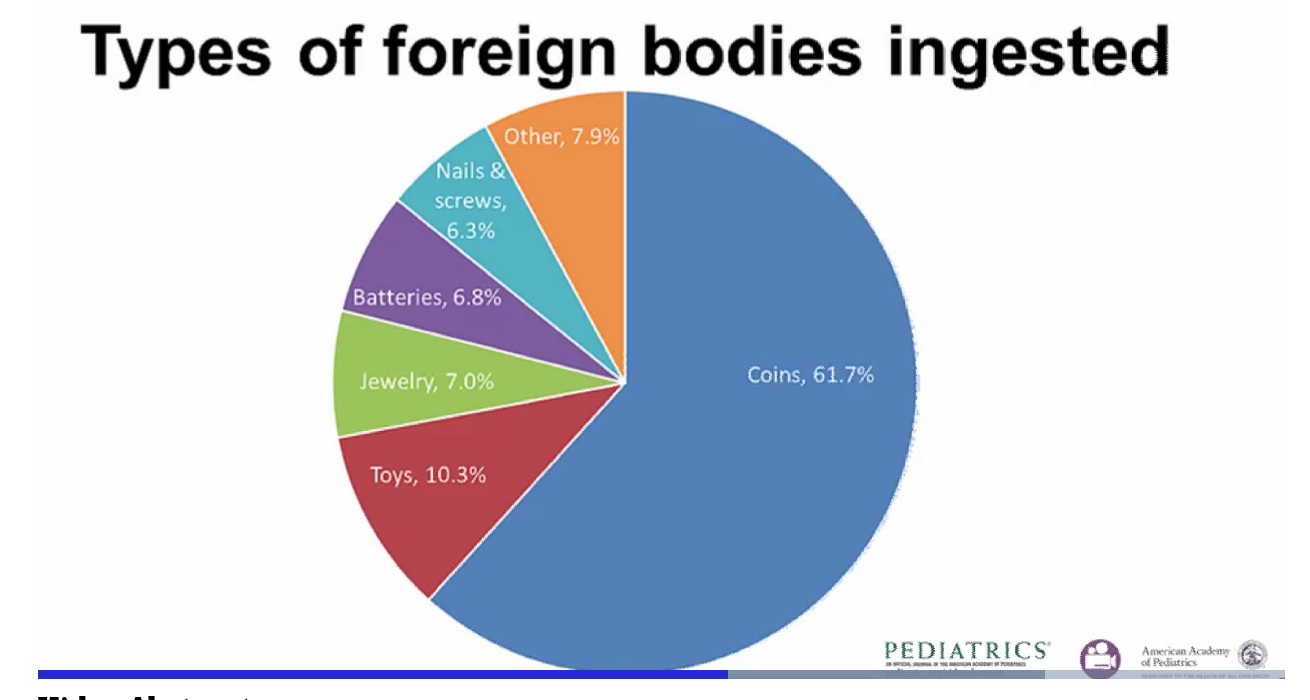New research published in Pediatrics analyzed the rate of foreign-body ingestions (FBIs) in young children (under age 6) only to determine it increased 91.5% over the study’s 21-year period. It is likely this is even an underestimation given this work only reviewed emergency department visits, not poison-control calls, urgent care stops or physician visits, for example. It is no surprise to discover FBIs are common in this age group. While many incidents wind up with everyone happy and a good story once much time has passed, it is important to distinguish the types of ingestions like button batteries and high-powered magnets that can cause profound injury and the need for urgent, aggressive medical intervention.
With coins being the most frequent, this chart elucidates the patterns researchers concluded. The extent of injury depends on the type of object and mechanism of exposure as well (ie inhalation versus ingestion, size of object and likelihood of getting stuck in various parts of anatomy).

The risks of accidental swallowing of foreign objects is higher in a home with small children (75% of all FBIs occur in those 5 or under) - as they developmentally mature they rapidly become more mobile, curious and stimulated by their environment so they put everything they can find in their mouth, up their nose etc. This normal exploration of their world can pose challenging when appreciating what is in their reach - especially with expanding volumes of electronic devices, toys, jewelry and other household staples.
Constant adaptations in child-proofing become essential, as from one week to the next toddlers amplify and extend their gains. Then, there is an added challenge of keeping those with special needs or particular medical conditions safe. Despite FBIs being a common occurrence in the very young, accidental or intentional ingestions of dangerous materials spans all ages, consider the precautions necessary for elderly patients with dementia (remember the issues with Tide Pods, see here) or the unique issues in adolescence when intent enters the picture (see here on the challenges of proper medication use depending on the population, or here and here).
Why batteries and magnets are so bad
Magnets are particularly worrisome, especially the high-powered types that often are in adult products -as are batteries, especially button batteries. Kids may think these are candy, and despite being tiny they may put an excessive number in their mouth. Teens pretend they are tongue piercings. When it comes to hazardous objects to swallow, magnets are up there (ie perforation, necrosis, sepsis, obstruction and death) in terms of high risk items - e.g. batteries corrode, sharp objects can pierce bowel. Button batteries are increasingly in more items and, if ingested, they can get lodged causing tissue damage and erosion due to their caustic nature - leading to strictures, necrosis, perforation and even death.
A mother’s agony was on full display in January when she posted her family’s harrowing experience on Facebook to raise awareness about an important topic that landed her young son in the hospital for an emergent removal of parts of his colon, intestine and appendix. After the boy accidentally ingested thirteen small magnets, they - due to the force of their strong attraction - stuck together eroding bowel and creating holes (aka perforations) that led to an infection. To review this case, see here.
A recent “study” further highlighted the profound spectrum of consuming inanimate objects. In it, the authors ingested smooth, round plastic Lego heads and sifted through their own stools to affirm passage. They did so to learn more precise transit times so they could comfort parents during such occurrences. The Lego heads didn’t cause harm because they don’t possess the qualities of the more alarming products previously mentioned - which still doesn’t mean anyone should try what the researchers did.
In As Far As Ingesting Foreign Objects Go, Magnets Worse Than Many, I wrote about a Colorado toddler who required emergency medical intervention after ingesting 28 high-powered buckyball magnets. In that case of 2-year-old Ella McBrien, the magnets conjoined in a circular manner that began to erode and obstruct bowel. An early hole was being formed. Thankfully, two attempts with specialized endoscopy solved the problem and prevented major surgery that could have warranted removal of substantial portions of bowel. Losing segments of bowel can lead to longer term issues.
Gastrointestinal perforations can occur anywhere throughout the GI tract, e.g. esophagus, stomach, intestines, colon etc. When there is such a rupture, the contents contained within that purposely confined space get released freely into the abdomen or chest. Bowel contents --albeit stool, bile, stomach acid, food, bacteria or free air-- released into the sterile environment of its surroundings cause tremendous damage, toxicity, incite inflammation and infectious spread. In addition, they can impede neighboring structures. Rapid intervention is often necessary to prevent overwhelming infection (aka sepsis), tissue necrosis, shock, even death. Conservative measures like bowel rest from not permitting eating or drinking, intravenous fluids or antibiotics are initiated with other supportive efforts.
Foreign bodies in the body pose a hefty healthcare burden
Foreign-body ingestion and inhalation through accidental or intentional trauma represent a large chunk of the preventable injury health care burden - which is not only costly in monetary terms but also in degrees of anguish and often unnecessary suffering. In 2016, FBIs were the 4th most common call to poison-control centers for those 5 years of age or younger.
Though the items and circumstances vary, no age is spared.
A recent story swept the media about a woman who had to go to the hospital due to significant eye pain and swelling only for doctors to discover four bees were living under her lid, feeding off of her tears. To read more about how high velocity projectiles, chemical splashes, particle fragments, and creepy crawlers can jeopardize our sight, see here.
To learn more in general of adverse effects depending on the body part impacted, review my series on Inanimate Objects In Orifices (eyes, ear/nose/throat, penis, vagina, anus/rectum) and Animate Objects in Orifices: The Airway.
To understand more about the dangerous and preventable, click on these links:
-
As Far As Ingesting Foreign Objects Go, Magnets Worse Than Many
-
Accidental Or Intentional, Tide Pods Meant For Laundry Not Mouths.
To sum up
It is always a balancing act with small children to live life and not be overrun by incessant prevention efforts. A central focus on avoiding harms can steal some of the joy out of parenting, especially at those young ages. But, being sensible about your choices of and within their environment can spare a family a lot of unnecessary, grievous harm. Knowing your child is a crucial factor in the equation. Reducing accessibility of particularly concerning items and closely monitoring their behavior adjusting as they advance developmentally is a worthy endeavor that can readily and continuously be addressed with your pediatrician. These routine discussions and actions can yield great dividends. Additionally, if there is a suspected exposure, then seeking immediate medical care early is the safest measure.
SOURCE: Foreign-Body Ingestions of Young Children Treated in US Emergency Departments: 1995–2015 Danielle Orsagh-Yentis, Rebecca J. McAdams, Kristin J. Roberts, Lara B.McKenzie Pediatrics Apr 2019, e20181988; DOI: 10.1542/peds.2018-1988




